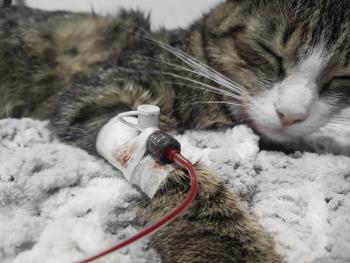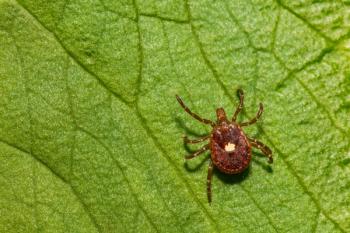
Comparing treatments for restoring the skin barrier in atopic dogs
A board-certified dermatologist discussed various topical treatment options at VMX 2023.
Content sponsored by Nextmune
At VMX 2023 in Orlando, FL, Domenico Santoro, DVM, MS, DrSc, PhD, DECVD, DACVD, DACVM, discussed restoring skin barrier in atopic dogs, including solutions to implement in daily cases.1
Topicals for atopic dermatitis
Topical therapies are a fundamental first-line therapy in atopic dermatitis that offer a lower risk of adverse effects.
“We can’t help our patients with just systemic drugs; we need a topical therapy, too,” Dr Santoro said. “Some [topical therapies] are characterized as moisturizers—emollients and humectants—anti-inflammatory agents, as well as anti-pruritic agents.”
Moisturizers
Moisturizers restore the skin barrier and have a decreased price point and a strong steroid-sparing effect, (ie, a large reduction in the use of systemic medications such as steroids.) In some situations, the efficacy of topicals has been compared to topical steroids, specifically decreasing the transepidermal water loss (TEWL) and increasing the skin-barrier function.
Emollients and humectants
Emollients are mainly oils, a spot-on treatment, or they are used in rinse or leave-in conditioners. Humectants have more hygroscopic agents, such as propylene glycol or colloidal oatmeal—they recall water from the lower level of the skin and the environment, so it increases the efficacy and internal vibration of the skin.
Colloidal oatmeal is a moisturizer that is anti-inflammatory and antihistamine, and it enhances the skin barrier. It also contains avenanthramides, which are soluble phenolic compounds; they have an antioxidant effect, a strong immunomodulatory effect, and they decrease inflammation, pH, and histamine-mediated pruritus and histamine, among other activities.
Ceramides
Ceramides decrease signal fields and binding of bacteria on the surface of the skin. One study, according to Santoro’s presentation, showed a 50% decrease in pruritus in 25% of dogs treated with a shampoo, Allermyl, containing ceramides, essential fatty acids (EFAs), and other ingredients, only after 24 hours.1
Phytosphingosines
Phytosphingosines are anti-inflammatory, antifungal, and antibacterial, and they inhibit cell growth. In a four-week study, weekly application of a chlorhexidine-phytosphingosine shampoo decreased bacteria count on keratinocytes of atopic dogs, but there was no significant difference with the vehicle. But another study showed daily application decreased the inflammatory response and pH.
Nonsteroidal barrier repair agents
In a study with 20 atopic dogs, daily application of a cream (composed of ceramide, cholesterol, and fatty acids) and weekly application of a shampoo (with oatmeal and a ceramide complex) for 4 weeks increased skin hydration, decreased TEWL, increased thickness and the continuity of the lipid bilayer and better lamellar body extraction. So, the dogs not only did better clinically, but also infrastructurally, Santoro said.
Essential fatty acids
EFAs have been around for a long time, but they take a while to work because for them to be effective, they need to go inside the cells and reabsorb in the bilayer. Placebo-controlled studies show a significant difference in clinical efficacy between dogs treated with EFAs versus placebo, including clinical signs of pruritis and other markers.
Essential oils
The objective of another study discussed by Santoro was to determine whether essential oils could increase the effectiveness of other medications. The 31-day open-label trial of 28 dogs with atopic dermatitis injected Cytopoint monthly with and without a weekly spot-on treatment and a shampoo with essential oils. The dogs that received the spot-on treatment and shampoo saw a 69% improvement in clinical lesions, more than 70% improvement in pruritis, and an improvement in cosmetic scope, essentially how your dog's skin looks. They were also able to increase the time of relapse, by four days, requiring a second injection.1
Bacteria
As most know, not all bacteria are bad. Santoro reviewed several human studies using bacteria, including dead bacteria, kill probiotics (probiotics that are not alive), and live organisms. Many of these studies gave headway to the animal space.
In veterinarian medicine, Santoro discussed a six-week open-label trial administered a spray once a day to 10 dogs with atopic dermatitis. The spray is made of two heat-treated bacilli (the configuration of the bacteria is almost identical to the live organism). The product was only sprayed for 20 days, but the dogs’ progress was followed after the treatment was discontinued. There was a 50% reduction in regional clinical scores after day 15; at days 28 and 42, there was a 90% reduction. At day 42, there was a significant reduction in pruritus.1
Reference
- Santoro D. Restoring Skin Barrier in Atopic Dogs. Presented at: Veterinary Meeting and Expo. January 14-18, 2023; Orlando, FL.
Newsletter
From exam room tips to practice management insights, get trusted veterinary news delivered straight to your inbox—subscribe to dvm360.




